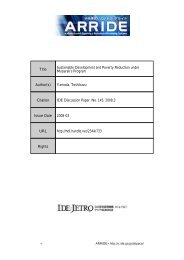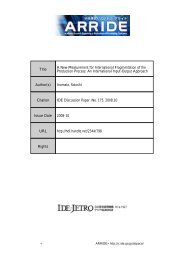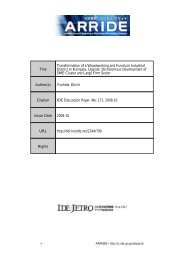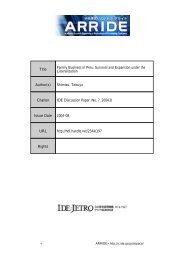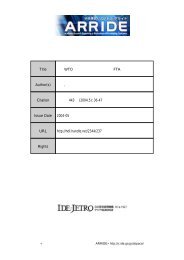Title Financing Small and Medium Enterprises in Myanmar Author(s ...
Title Financing Small and Medium Enterprises in Myanmar Author(s ...
Title Financing Small and Medium Enterprises in Myanmar Author(s ...
Create successful ePaper yourself
Turn your PDF publications into a flip-book with our unique Google optimized e-Paper software.
us<strong>in</strong>ess decision mak<strong>in</strong>g keep them from provid<strong>in</strong>g the banks complete <strong>and</strong> systematic<br />
set of account<strong>in</strong>g so these banks can make a credit review. Some bus<strong>in</strong>esses even<br />
ma<strong>in</strong>ta<strong>in</strong> dual set of account<strong>in</strong>g statements. One is for <strong>in</strong>ternal use (true one) <strong>and</strong><br />
another one, which will be submitted to tax authorities, is designed to reduce the taxes<br />
bus<strong>in</strong>ess owners have to pay. They are not will<strong>in</strong>g to present their <strong>in</strong>ternal records to<br />
the banks <strong>in</strong> order to get bank loans. In this case, they use <strong>in</strong>dependent accountants to<br />
prepare a set of account<strong>in</strong>g records for them that can be useful only for loan application<br />
purposes. Consequently, most of the account<strong>in</strong>g records submitted to the bank for loan<br />
application are not totally reliable, s<strong>in</strong>ce they do not reflect the true states of the<br />
bus<strong>in</strong>ess. Therefore, banks do not rely on these f<strong>in</strong>ancial statements to make objective<br />
analysis for their loan decisions.<br />
The third reason for these bus<strong>in</strong>ess owner-generated problems is that many SME<br />
owners <strong>in</strong> <strong>Myanmar</strong> do not have the skill to make a bus<strong>in</strong>ess plan that can be used to<br />
assess the feasibility of a project. Most small bus<strong>in</strong>esses usually start without a formal<br />
bus<strong>in</strong>ess plans. Banks also rarely dem<strong>and</strong> bus<strong>in</strong>ess plans to review the risk of their<br />
customers’ bus<strong>in</strong>esses <strong>in</strong> mak<strong>in</strong>g loan decisions. They solely rely on the viability of their<br />
collaterals <strong>in</strong> mak<strong>in</strong>g loans decisions. Due to this, SME owners cannot systematically<br />
<strong>and</strong> objectively make judgments on the potentials of their planned bus<strong>in</strong>ess. Instead,<br />
they use subjective judgment <strong>and</strong> personal experiences to run <strong>and</strong> manage bus<strong>in</strong>esses.<br />
This can lead to reduced quality of their decision mak<strong>in</strong>g as well as missed<br />
opportunities. Indeed, a good bus<strong>in</strong>ess plan can help <strong>in</strong> ga<strong>in</strong><strong>in</strong>g access to a more<br />
favorable credit l<strong>in</strong>e offered by the banks <strong>and</strong> can be used as part of collateral<br />
requirement.<br />
Fourth, some SMEs cannot effectively manage the money they have borrowed.<br />
Traditional SMEs do not know how to manage their cash flow to meet their payment<br />
bus<strong>in</strong>ess obligations on time. This problem leads to overspend<strong>in</strong>g <strong>in</strong> some occasions <strong>and</strong><br />
over borrow<strong>in</strong>g <strong>in</strong> other occasions. Some traditional SMEs cannot even dist<strong>in</strong>guish<br />
between personal <strong>in</strong>come <strong>and</strong> bus<strong>in</strong>ess <strong>in</strong>come, as well as personal spend<strong>in</strong>g <strong>and</strong><br />
bus<strong>in</strong>ess spend<strong>in</strong>g. When they get a large amount of money from the bank, they do not<br />
use the money <strong>in</strong> their bus<strong>in</strong>esses <strong>and</strong> <strong>in</strong>stead, they use it for personal expenditures. In<br />
some cases, they offer longer credit terms to their customers more than what they can<br />
actually manage. Thus, they would have no enough money to pay the banks the<br />
pr<strong>in</strong>cipal amount of their loans. As a consequence, bus<strong>in</strong>esses go bankrupt.<br />
Aside from <strong>in</strong>adequate collaterals, lack of proper account<strong>in</strong>g statements, <strong>in</strong>ability<br />
to prepare comprehensive bus<strong>in</strong>ess plans, <strong>and</strong> poor cash management, the difficulty <strong>in</strong><br />
obta<strong>in</strong><strong>in</strong>g loans also lies on the exist<strong>in</strong>g perception of banks that lend<strong>in</strong>g to SMEs<br />
proves too risky. This has been compounded by the <strong>in</strong>stances of high NPLs <strong>in</strong> the history



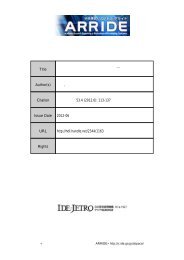
![Title [書評] 廣田義人著『東アジア工作機械工業の技術形成 ... - ARRIDE](https://img.yumpu.com/47139953/1/184x260/title-arride.jpg?quality=85)
